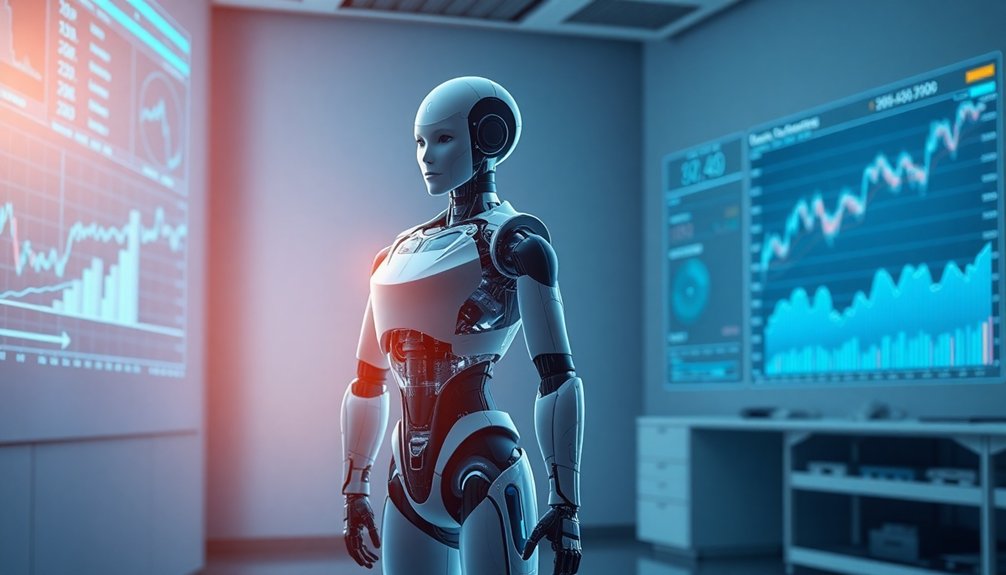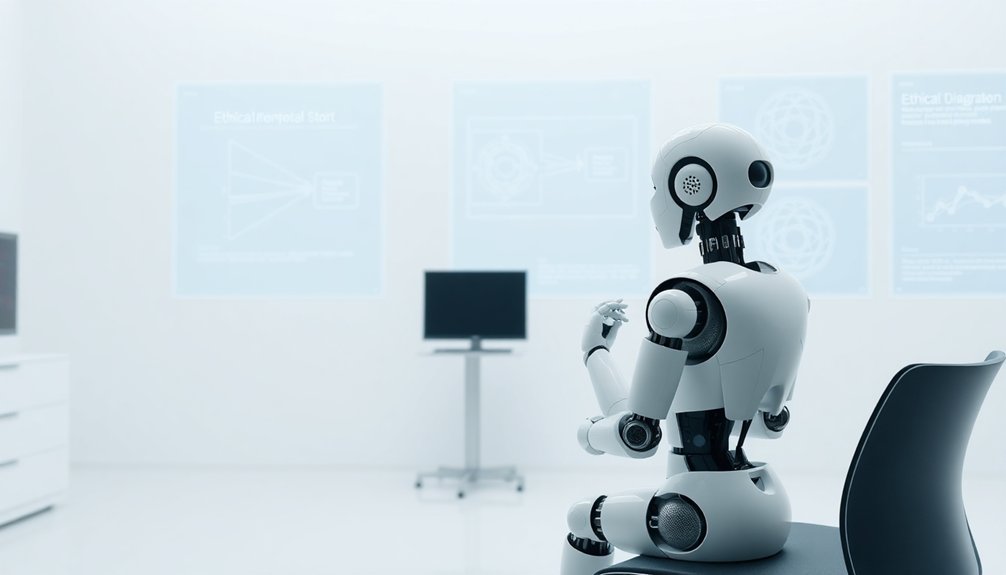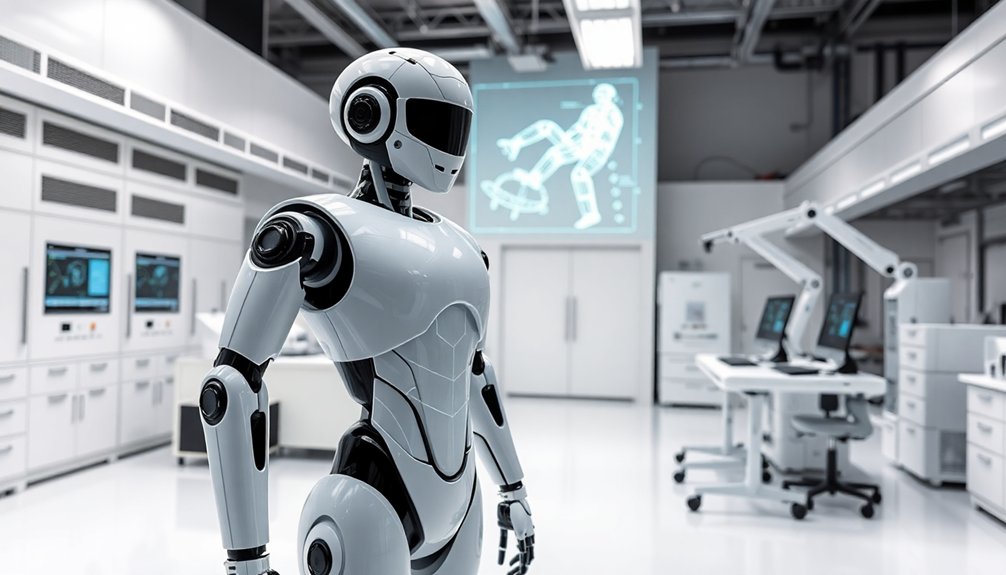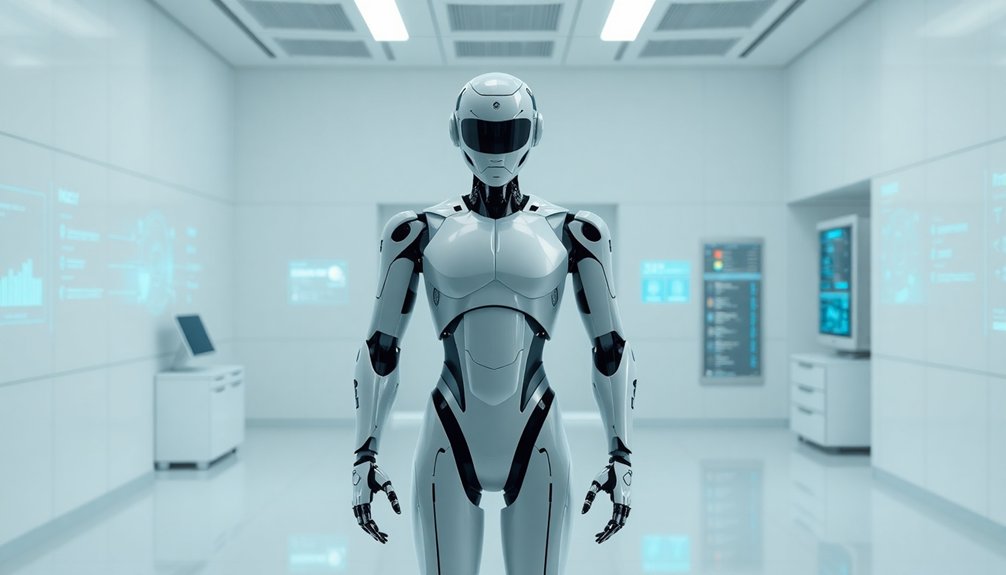Imagine robots that aren’t just metal, but potential companions who understand you. Humanoid technologies are rapidly evolving to provide emotional support, healthcare monitoring, and adaptive interactions. You’ll soon encounter machines that learn, remember conversations, and respond with surprising nuance. They won’t replace human connections, but they’ll fill emerging emotional gaps in our increasingly isolated world. Want to know how deep this rabbit hole goes?
What Are Humanoid Robots?

Imagine a machine that walks, talks, and thinks just like you—but without the messy human emotions. Humanoid robots are the future’s answer to our deep craving for connection, blending advanced AI with mechanical magic to create companions that might just understand you better than your friends.
These social interaction wizards aren’t just cold technology; they’re designed to provide emotional support in ways traditional machines never could. Want healthcare monitoring? Companionship? A non-judgmental listener? These AI-powered buddies are ready.
They learn, adapt, and remember conversations, bridging the gap between human need and technological possibility. But here’s the real question: Are they replacing human relationships or just filling a profound emotional void we’re too afraid to admit exists? With cutting-edge humanoid robots like Figure 01 and Tesla Optimus Gen 2 now available, we’re entering an era where technological companionship is no longer science fiction.
Key Technological Breakthroughs
From dreaming about humanoid companions to making them real, technology’s quantum leap isn’t just happening—it’s breaking through walls we thought were unbreakable.
AI and robotics are transforming personal robots from clunky machines into adaptive, intelligent companions. Humanoid robotics now leverage advanced natural language processing, letting robots understand and respond like real conversation partners.
These innovations aren’t just technical—they’re reshaping how we interact with machines. Modular designs mean you can customize your robot like a digital Swiss Army knife, adding capabilities that match your lifestyle.
Ethical AI frameworks guarantee these technological marvels respect privacy and make responsible decisions. Humanoid robot brokers like FutuRobots are now connecting clients with advanced robotic companions that offer unprecedented interaction capabilities.
Will robots become our ultimate sidekicks? With breakthroughs in human-robot interaction, social activities are getting a radical upgrade—and they’re just getting started.
Market Evolution and Economic Impact

When the market for personal robots shifts from sci-fi fantasy to economic reality, we’re looking at a seismic transformation that’ll make the tech revolution look like a warm-up act. Humanoid robots are about to rewrite the economic playbook, turning companionship and healthcare into billion-dollar industries.
| Market Segment | Potential Impact | Growth Projection |
|---|---|---|
| Healthcare | Labor Efficiency | High |
| Personal Care | Emotional Support | Medium |
| Industrial | Operational Scaling | Significant |
| Companion Robots | Social Interaction | Emerging |
| Tech Innovation | Economic Disruption | Transformative |
Want real connection? These robots aren’t just machines — they’re economic game-changers. From $175,000 companion bots to healthcare assistants, personal robots represent more than technology. They’re solving global loneliness, filling labor gaps, and creating entirely new market opportunities that’ll make traditional industries look obsolete. The future isn’t just coming — it’s here, and it’s wearing a robotic face.
Practical Applications Across Industries
Because technology never sleeps, personal robots are quietly revolutionizing industries most people didn’t even know needed disrupting.
Humanoid robots are transforming healthcare settings, with machines like Moxi handling critical logistics and saving staff countless steps. In elder care, companion robots aren’t just machines—they’re emotional bridges, connecting isolated seniors to meaningful interaction.
Robots: silently bridging emotional gaps, transforming healthcare and elder care with compassionate, intelligent support.
Want patient engagement that doesn’t feel robotic? Robots like Pepper are redefining hospital experiences, guiding patients and providing personalized assistance.
Education isn’t immune either; interactive tutors adapt to individual learning styles, making traditional teaching look outdated.
From retail customer support to complex medical deliveries, these intelligent machines are proving they’re more than sci-fi fantasies. They’re practical problem-solvers, quietly reshaping how we work, learn, and connect.
Ethical Considerations and Social Implications

As personal robots increasingly infiltrate our daily lives, the ethical minefield they create demands our immediate attention.
You’ll face tough questions about technology reliance and user autonomy. Can a machine truly provide companionship without manipulating your emotions? Responsible development means wrestling with complex social acceptance challenges.
These robots collect intimate data, blurring privacy lines faster than you can blink. The emotional impact on vulnerable populations like seniors is profound and potentially dangerous.
Who decides the boundaries between helpful technology and emotional dependency? Ethical considerations aren’t just academic debates—they’re real-world concerns about how artificial entities might reshape human connection.
We’re not just talking about gadgets; we’re discussing the future of human interaction itself.
Proceed with caution, curiosity, and critical thinking.
Leading Innovators and Research Institutions
The robotics landscape is a wild playground of innovation, where tech giants and research powerhouses are racing to build machines that could radically transform human experience.
You’re witnessing pioneers like Boston Dynamics and Hanson Robotics designing robots with human-like appearance that challenge our understanding of social interaction. From Atlas’s incredible mobility to Sophia’s groundbreaking citizenship, these machines aren’t just tools—they’re potential companions capable of handling daily tasks and providing emotional interaction.
Robots are evolving beyond tools, emerging as potential companions with human-like interactions and emotional intelligence.
MIT’s cutting-edge research pushes humanoid robotics forward, while companies like SoftBank and Tesla prove that robots aren’t sci-fi fantasies anymore. They’re real, they’re evolving, and they’re getting closer to understanding us.
But here’s the million-dollar question: Are we prepared for robots that might comprehend us better than we understand ourselves?
Design Challenges and Emerging Solutions

When robots step out of sci-fi fantasies into our living rooms, they’ll need more than cool hardware—they’ll need seriously smart design. Humanoid robots aren’t just fancy toys; they’re complex machines wrestling with real-world interaction challenges.
How do you make something feel human without creeping people out? Design teams are tackling this by developing modular robots with customizable personalities and micro-motor facial expressions that dodge the “uncanny valley” problem.
Emerging solutions focus on safety, trustworthiness, and emotional intelligence. They’re creating robots that can navigate unpredictable spaces, understand subtle social cues, and integrate smoothly with smart home tech.
User acceptance hinges on ethical design that respects human boundaries and feels genuinely helpful, not invasive. The future isn’t about replacing humans—it’s about intelligent companionship.
Global Perspectives on Human-Robot Interaction
While global attitudes toward robots might seem like a nerdy tech debate, human-robot interaction is quickly becoming a worldwide cultural phenomenon that’ll reshape how we connect, care, and communicate.
Humanoid robots aren’t just sci-fi fantasies anymore — they’re real companions transforming healthcare, emotional support, and social dynamics.
From Japan’s empathy-driven designs to Europe’s ethical frameworks, each region brings unique perspectives to companion robots.
Robot companions reflect cultural diversity: technological innovation meets human empathy across global landscapes.
Can machines truly understand human vulnerability? The research suggests yes, but with critical caveats.
Social behavior and emotional connections matter more than slick technology. Your future robot friend won’t just be a gadget; they’ll be a nuanced interaction partner who understands context, remembers conversations, and adapts to your emotional landscape.
The revolution isn’t about replacing humans — it’s about expanding our understanding of connection.
Future Trajectories and Potential Transformations

As personal robots evolve from sci-fi dreams into tangible realities, you’ll witness a radical transformation in how technology interacts with human emotion and daily life.
Imagine companions that adapt to your needs through incredible customization, seamlessly integrating with smart home systems while understanding your deepest emotional landscapes. These aren’t just machines; they’re responsive partners powered by advanced language processing that feels almost magical.
Will ethical frameworks protect us from potential pitfalls? You’ll navigate a world where robots become more than tools – they’re potential confidants who learn, grow, and connect with unprecedented intimacy.
The $85 billion market isn’t just about technology; it’s about reimagining human connection. Personal robots are set to challenge everything we thought we knew about companionship, blurring lines between artificial intelligence and genuine understanding.
Final Thoughts
Robots aren’t just sci-fi fantasies anymore – they’re becoming real partners in our lives. Sure, we’ve got challenges around privacy and human connection, but innovation always breaks through old barriers. The next decade will reshape how we think about machines: less cold technology, more collaborative companions. Are you ready to reimagine what’s possible when human creativity meets robotic potential? Technology’s wild ride is just beginning.
